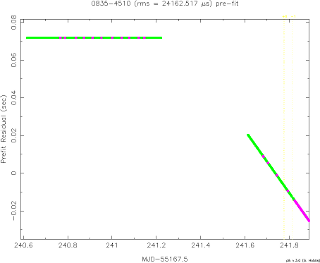
HartRAO Home >
news >
Vela pulsar glitch detection 2010/07/31
Vela pulsar glitch detection 2010/07/31
The Vela pulsar (PSR J0835-4510) is the brightest radio pulsar in the sky.
Pulsars are the collapsed remnants of stars that exploded as supernovae and
are only are about 20km in diameter. The Vela pulsar is young and exhibits
sudden jumps, or "glitches", in its rotation rate. These typically occur at
intervals of a few years.
Close monitoring of the way in which it recovers from each event provides
clues to the interior structure of the object.
HartRAO astronomer and PhD student Sarah Buchner has been monitoring the Vela pulsar
as part of her research. This was disrupted by the failure of the bearing
in the 26m telescope at Hartebeesthoek in 2008 October. However, she was
given access to the 15m eXperimental Development Model (XDM) prototype for
the Karoo Array Telescope built by the South
African SKA Project in between tests by the KAT development team. XDM
is fitted with a 1.4-1.6GHz receiver and multi-channel "IBOB" FPGA-based
backend, designed for rapid sampling. In collaboration with the KAT team,
Sarah adapted the XDM software for pulsar timing, which requires continuous
recording of rapidly sampled data. Maintaining continuous observing took a
lot of effort from Sarah and the KAT team, with various teething problems
having to be ironed out.

Left click on image for large version.
Typical dynamic spectrum of the Vela pulsar obtained with XDM, showing how
the pulse arrival time is frequency-dependent owing to ionised interstellar
medium. The graph at top shows the pulse profile after dedispersion.
By the time of the 26m repair in mid-2010, the interval of
nearly four years since the last glitch on 2006 August 12 was one of the
longer such intervals, so Sarah was very keen to get the 26m telescope
back after the repair in order to get data from both telescopes for
comparison.

Left click on image for large version.
Vela pulse arrival time residuals from XDM (green) and the 26m telescope
(purple in squares) before the glitch.
As part of recommissioning testing, Sarah restarted pulsar observing with
the 26m telescope on 2010 July 23.

Left click on image for large version.
The 15m XDM (left) and recommissioned 26m telescope (right) observing the
Vela pulsar on July 23.
Eight days later the Vela pulsar glitched.

Left click on image for large version.
Change in pulse arrival times after the glitch compared to pre-glitch. Data
in green from XDM, from 26m in purple.
The glitch occurred shortly after the pulsar had set at HartRAO.
Processing the data from XDM shortly after it rose the next morning, the
telltale signature of the glitch was apparent (above). XDM has an
alt-azimuth mount, so it sees the pulsar when it rises above the hills. The
26m can only see it about two hours later, owing to its polar mounting and
the southern declination of the pulsar.
Shortly after the pulsar became observable with the 26m telescope, Sarah was
able to confirm the glitch with the second telescope. Thereafter the pulsar
was monitored continuously with both telescopes in order to characterize its
recovery behaviour.
Sarah reported in
Astronomers Telegram #2768 on August 1 that
"An increase in the rotation frequency of PSR J0835-4510 of
magnitude [Delta(nu)]/nu = +1.94 E-6 has been observed, using the KAT
prototype, with the "glitch" occurring on Jul. 31.802 UT. Fourteen
hours of observations, commencing 7.4 hours after the event, indicate
an accompanying fractional increase in the spin-down rate of +0.075
+/- 0.001."




